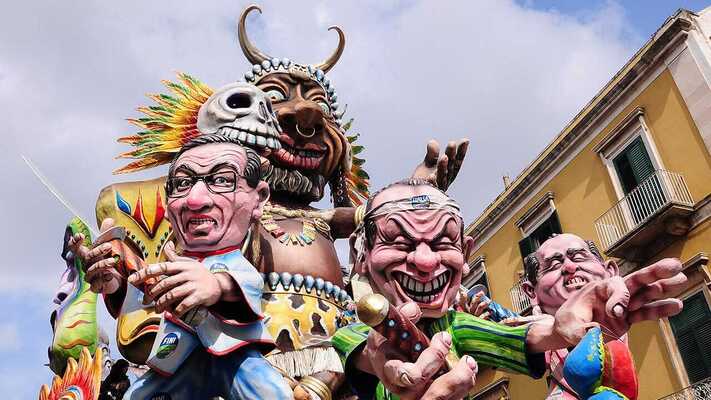The carnival in Salento: art, culture and folklore
The month of February could be an excellent time to spend a holiday in Salento, as masks, confetti, Salento delicacies and lots of fun will be the main ingredients that will enliven the Carnival in Salento Greece with cheerful and lively colours. It is a festival in which art, intercultural meetings and twinning with different countries intersect and which give life to events characterized by folklore intertwined with religion.
An event full of sensations and allegorical demonstrations, which in some parts of the world is an unfailing tradition, to be safeguarded and preserved, to be carried forward and celebrated.

The origins of Carnival in Salento
Initially a Catholic tradition, then transformed over time from a purely pagan ritual, oriented towards exaggeration and subversion of the patterns in which society existed, to a ritual of abundance and celebration before the long period of fasting that comes with Lent, which ends with the arrival of Easter.
The celebrations have very ancient origins and have their roots in the Dionysian or Saturnalia rituals of the medieval era, handed down to us by a strong typically Salento popular spirit.
In Salento, the carnival period generally begins on January 17th and coincides with the “focare” ritual, i.e. the lighting of enormous piles of olive branches dedicated to S. Antonio Abate, in various points of the city.
Countless towns in the province of Lecce organize themselves for the great event: Casarano, Copertino (with its characteristic lu Paulinu mask), Corsano, Aradeo, Andrano and Borgagne (famous for the town’s musical band), Martignano, Scorrano (famous for the songs and dances during the Pascalino fire), Nardò and Melendugno, Supersano etc…
Carnival in Gallipoli: between rites and traditions
The oldest Carnival is that of Putignano, but the culmination of this period arrives with the parade organized in Gallipoli thanks to the intervention of the excellent Lecce artisans who were able to bring the art of papier-mâché to the highest levels, obtaining true masterpieces.
The traditional mask of the Gallipoli carnival is “lu Titoru”. Theodore, kept away from his homeland, ardently desired to return to his homeland at least for the Carnival, that is, in the period in which everyone could enjoy the abundance of food and have fun, before the advent of Lent. Even Teodoro’s mother, the “Caremma“, who was worried about her son, prayed that God could grant him a few days of extension of the Carnival, and her pleas were heard.
The celebration was extended by two days (“li giurni de la bianca”) and Teodoro was able to arrive in Gallipoli in time to enjoy the celebration. It was a Tuesday and Teodoro, to make up for lost time, ate so many tons of sausages and pork meatballs that he was choked. Thus, on that tragic Shrove Tuesday, Teodoro died and with him the Carnival also died, among the screams of pain that accompanied his coffin.
For this reason, he paraded a cart with a straw puppet representing Lu Titoru in procession through the streets of the city. Everyone got on their knees and showed their compunction and thus began, from Ash Wednesday, the penance that lasted for forty long days, the days of Lent.
After Ash Wednesday, on Thursday the “Pentolaccia” is celebrated, which gives the opportunity to consume the last remnants of the now concluded Carnival. It is a large pot, a “pignata“, containing sweets and sweets of all kinds which the children must break in order to gain possession of the precious contents.

Putignano Carnival 2020: Five events not to be missed
The Putignano Carnival is certainly one of the most famous events in Puglia. Apulian carpenters and master papier-mâché makers will create true works of art renowned throughout Italy.
